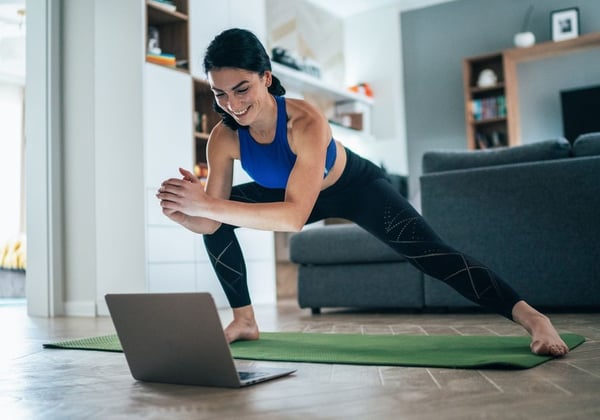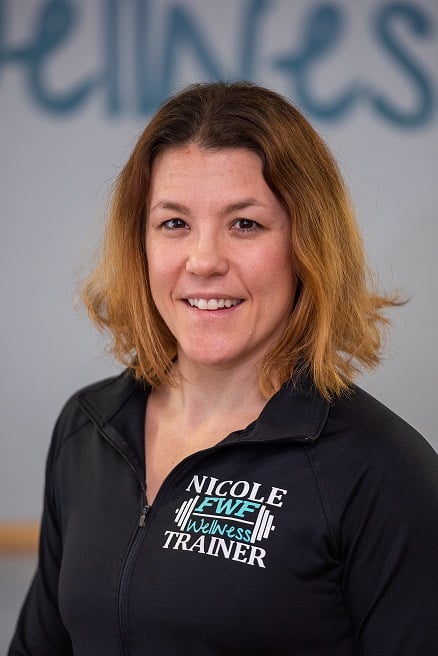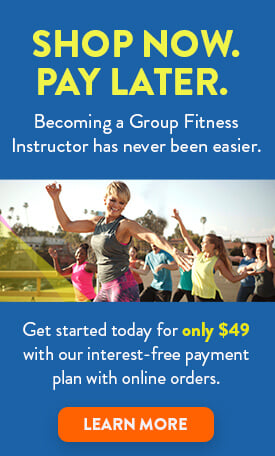
Imagine you are a successful group fitness instructor. It has taken you many years to build up your skills, class numbers, and clientele. Suddenly, your successful group fitness practice was smashed by public notices that your facility must shut down immediately. You are stunned. You know the fitness industry may never look quite the same going forward. You know you must adapt.
Perhaps you had thought about expanding your fitness business virtually, but never had the time, drive, or technology to make it happen. Remember, hard times spark innovation, and now is the time to innovate!
If you would like this guide as a downloadable PDF, as well as access to additional bonus content on virtual training in a group fitness format, be sure to visit our free mini course on online group training.
Our First Virtual Group Fitness Course
For an example of what an online training course might look, let's quickly analyze our first virtual training course - and the challenges that ensued. Despite it seemingly starting off as a disaster, we quickly adapted!
We received the governor’s order to shut down in-person operations on March 19, 2020, and were given little more than 24 hours’ notice. The instructor team was devasted.
We knew that our clients depended on us for their physical and psychological health and well-being, as we rely on them for ours. We taught our final in-person classes that Friday and began gathering up whatever audio equipment we had to attempt our first virtual class the next day. There was no demo, no test group- we simply moved forward
The first virtual class (a virtual indoor cycling class) went live the following day. It was very awkward teaching to a computer, but there were no catastrophic failures, so we made the decision to put our entire class schedule online. We were encouraged to see that was had a large group of 17 clients signed up for our Sunday Strong Nation® class.
This class was an epic failure.
There were connectivity issues, user unfamiliarity, and audio-visual quality problems with this first large class. We received feedback that our audio-visual quality was poor. Several clients could not figure out how to log on to the meeting; others were kicked off and could not get back in the meeting.
This did not stop us. We continued to offer classes online. Each class brought us more insight into how to make the next one better. All in all, we had most of our technical and logistical problems worked out within three weeks.
Platforms Currently Available for Online Group Fitness
There are several online meeting software options on the market with more group fitness-specific products currently in development. Online group conferencing software such as Zoom, Go to Meeting, and Google teams can be adapted for group fitness classes. Each of them has a slightly different layout and pricing structure, but they range in price from $12.00 to $30.00 monthly (Fearn, 2019).
Similarly, group fitness-specific software such as Burn Along and Virdio are currently in the final phases of development. Virdio is a fitness-specific group conferencing software in its final stages of development. Pricing is not finalized yet, as the developers are moving to perfect the software platform. According to Brent Platt, a Virdio representative, the full version of the software will likely launch in July. However, instructors can test the software at no cost until that point (B.Platt, personal communication, May 3, 2020).
BurnAlong is a bit different. The company pays instructors a fee quarterly based on the amount of time BurnAlong clients access that instructor’s content instead of the instructor subscribing to the software (BurnAlong, 2014). Currently, we are most familiar with Zoom meeting for broadcasting our classes at FWF Wellness.
I am a Group Fitness Instructor, not an AV Engineer
Creating a high-quality audio-visual experience was the most frustrating part of our journey. We ended up consulting with an audio engineer to help us troubleshoot sound issues. This is the breakdown of what we found works best after weeks of tinkering with soundboards and settings.
- Use a laptop or computer-broadcasting from a tablet or smartphone will diminish the music quality.
- Using a soundboard, USB interface, and portable headset fed directly into the soundboard and plugging that directly into the USB port on the computer creates the best quality sound. Your music source (most likely your phone or tablet) can be plugged directly into the soundboard. You then connect your speaker into the soundboard and then plug the USB interface (or bypass the USB interface and use a ¼ inch to USB cord) to feed that into your computer.
- Zoom settings: Click on the microphone and make sure the USB soundboard (or condenser mic) is selected. Then, go to advanced settings. Make sure to disable any settings that will automatically block out background noise or automatically adjust the volume. Also, make sure you enable the user to use original sound and enable stereo sound.
- Condenser microphone: You can use a condenser microphone to enhance the sound (make sure you apply the same Zoom settings) if you do not have access to a soundboard. These range in price from $15.00 to $100.00. You simply plug them into the USB port and make sure you click the microphone icon to select it as the sound source.
- Use a high definition webcam instead of the internal camera that comes with the computer for the best picture quality.
Legal Aspects of Online Group Fitness
Insurance
You must check with your liability insurance carrier to make sure your policy covers online training. Many insurers (such as K&K) have made amendments to the policies to cover online training since the COVID-19 crisis began. Still, you must verify with your carrier to understand the specific terms of your policy (K & K Insurance Group, 2020).
Licensed Classes (i.e., Pound®, Zumba®, Beach Body live classes, Spin®, etc.)
The majority of licensing agreements for licensed classes prohibit virtual training. However, considering the COVID-19 crisis (and likely moving forward), this portion of the licensing agreements are suspended. Luckily, if you are AFAA certified, you can create your classes, which will not be subject to a licensing agreement. Again, make sure you check with the entity licensing your classes before offering a virtual option.
Music Licensing
The rules for live-streamed classes are the same as for live classes. Instructors that are given music from a licensed format (i.e., Beachbody or Zumba) can play that specific music in fitness classes. There is also the option to subscribe to pre-mixed fitness-specific music through companies such as YES (YES, 2020).
However, to use music from other artists, fitness facilities or individual instructors must pay licensing fees to three major entities (BMI, ASCAP, or SESAC). The costs are determined based on the predicted amount of yearly class participants. These licenses only cover a live performance even if you hold the license. It is essential that you avoid recording and offering on-demand services for this reason. The licensing requirements to provide recorded performances are more complicated (Biscontini, 2014).
Social media sites such as Facebook and YouTube have an algorithm that can detect a copyright violation. Often, you may find your Facebook live class muted suddenly or receive a message indicating you violate copyright laws (Facebook Help Center, 2020). Teaching online classes on these platforms is not advised.
Liability Waivers, Clearances, Media Release, and Informed Consent
Liability waivers are a must for any group fitness class; however, you may need to change the language of your current liability waiver to include online classes. Likewise, if you have clients participating from specific states that do not favor liability waivers (e.g., Virginia, Montana, New Mexico, and Louisiana), they will do little to protect you. The same standards apply to virtual clients as do in-person clients concerning medical clearances, media releases, and informed consent (Montgomery Law, LLC, 2017). Fitness management software such as Zenplanner™ offers the ability to accept electronic signatures for these documents. Docusign™ is an excellent option if you do not have access to fitness management software, as is a simple sign, scan, and email.
Payments and Links: Navigating the Logistics
One aspect of online classes that differs significantly from an in-person experience is the necessity of sending your paid clients a link for the class. We use Zen Planner software, which allows clients to register online. The instructor will then pull the class list from Zen Planner and send the links to registered clients either via Facebook message or email.
We ask that clients reserve an hour before the class start time though clients are welcome to join at any time at the instructor's discretion. Sometimes, we will create a reoccurring Zoom meeting and send it to all clients currently and previously registered for the class if they have a credit card on file. This gives them the flexibility to attend as a drop-in.
You can also use PayPal and simply keep a spreadsheet of your participants. Overall, you must find out what system works best for you as an instructor or facility owner/manager.
Flexibility is Key
Home equipment has been increasingly difficult to purchase through the COVID-19 crisis though that may change going forward. However, there are ways around this.
- Order equipment for your clients if you have a direct supplier. Check your local area for places to purchase wholesale equipment.
- Choose formats that require little to no equipment (i.e., dance formats, bodyweight training, mat Pilates, etc.).
- Adapt your current formats. For instance, we were able to convert our indoor cycling format to include treadmills, ellipticals, and outdoor runners/cyclists. The format involves cycling/running intervals coached through rate of perceived exertion (RPE) levels. Likewise, clients can use household items such as bags filled with books, milk jugs filled with sand or rocks, water bottles to substitute for dumbbells.
Building Your Virtual Tribe
The basic principles of building a successful group fitness class apply to online classes. The instructor needs to provide a welcoming environment, clear cues (verbal or visual), appropriate regressions and progressions, and help their clients have fun (McGill, 2017).
- Invite participants to enter the class meeting 15 minutes before the start time. Welcome each of them by name and start a conversation.
- Create online “class chatter” groups where participants can continue to interact before and after the class.
- Talk to them while you teach. You may say something like “Donna, this song is for you” or “I know how much Mary Sue loves burpees.”
- Challenge them to post sweaty selfies or their workout summaries.
- Invite your participants to suggest themed classes or request specific routines and exercises.
- Encourage your students to tag you on social media channels and encourage their friends to join classes.
Hybrid programs
Hard times spark innovation. Virtual classes are more than a temporary solution to an unprecedented problem. They give you the ability to expand your reach as a fitness instructor far beyond your geographic region. It also makes fitness classes accessible to other populations who may not be able to attend in person. The investment in a successful virtual program will serve you well beyond the COVID-19 crisis.
For additional tips and tricks for online fitness training, Premier Global NASM has a good guide you can check out here. Since COVID ramped up, they have accomodated their customer base and switched their diploma courses over seamlessly to 100% digital. They know a thing or two about pivoting during the pandemic!
References
Biscontini, L. (2014). Music Management: Effectively (and Legally) Unleash the Power of Music. ACE Fitness. https://www.acefitness.org/certifiednewsarticle/808/music-management-effectively-and-legally-unleash-the-power-of-music/
BurnAlong. (2014). BurnAlong | Corporate Wellness Platform and Online App. BurnAlong. https://www.burnalong.com/
Facebook Help Center. (2020). Copyright | Facebook Help Center | Facebook. Www.Facebook.Com. https://www.facebook.com/help/1020633957973118/
Fearn, N. (2019, November 20). Best online collaboration tools of 2020: share, edit, plan, and communicate online. TechRadar; TechRadar pro. https://www.techradar.com/best/best-online-collaboration-tools
K & K Insurance Group. (2020, March 19). Fitness Instructors - K&K Insurance Group, Inc. Www.Kandkinsurance.Com. https://www.kandkinsurance.com/sites/Fitness/Pages/Fitness-Instructors.aspx
McGill, E. (Ed.). (2017). Principles of Group Fitness Instruction. Jones & Bartlett Learning.
Montgomery Law, LLC. (2017, December 8). Online Coaching Risks & Liability | Montgomery Law, PLLC. Montgomery Law, PLLC. https://montgomerypllc.com/online-coaching-risks-liability/
Platt, B. (2020, May 3). Virdio Specifics (interview by N. Golden) [Personal communication].
YES. (2020, March 20). Yes! Fitness Music : Discover new music. Teach better classes. Workout Music for Aerobic Instructors. Www.Yesfitnessmusic.Com. https://www.yesfitnessmusic.com/mymix/custom


